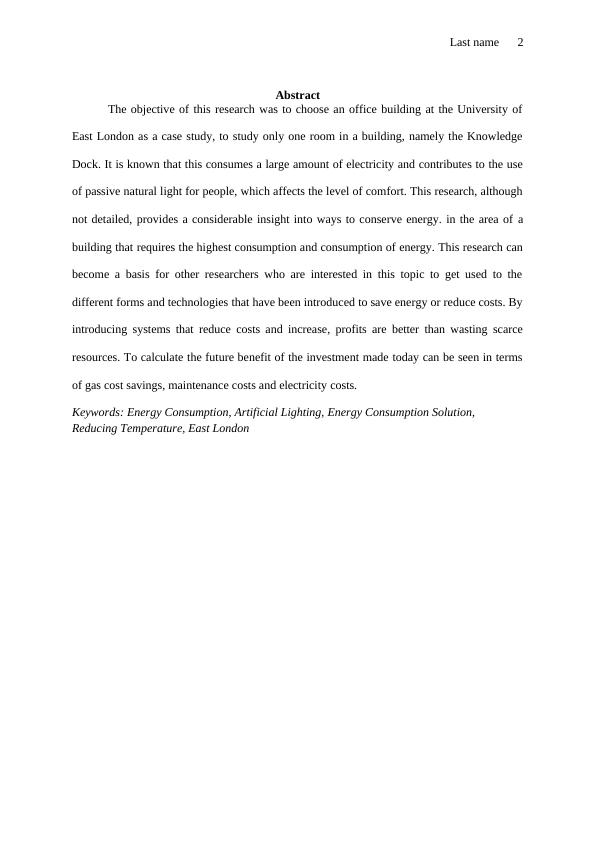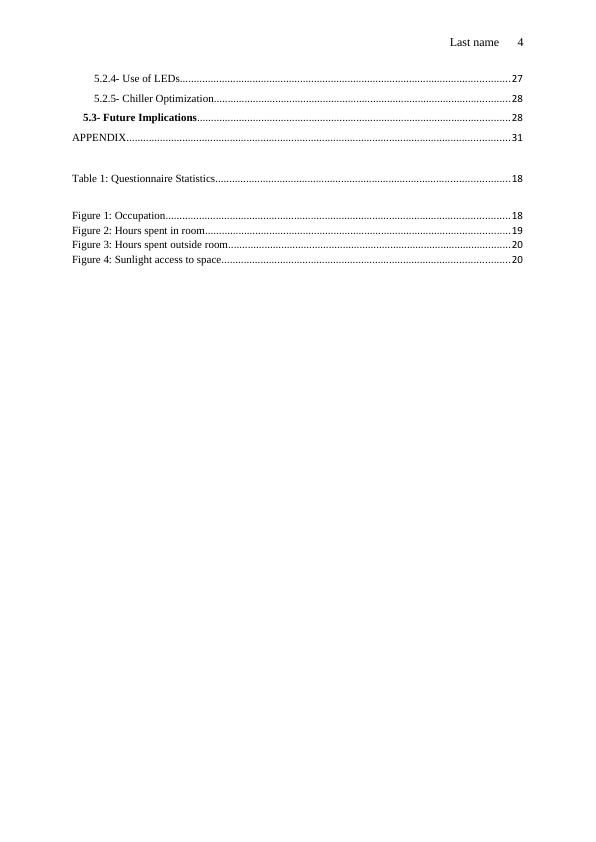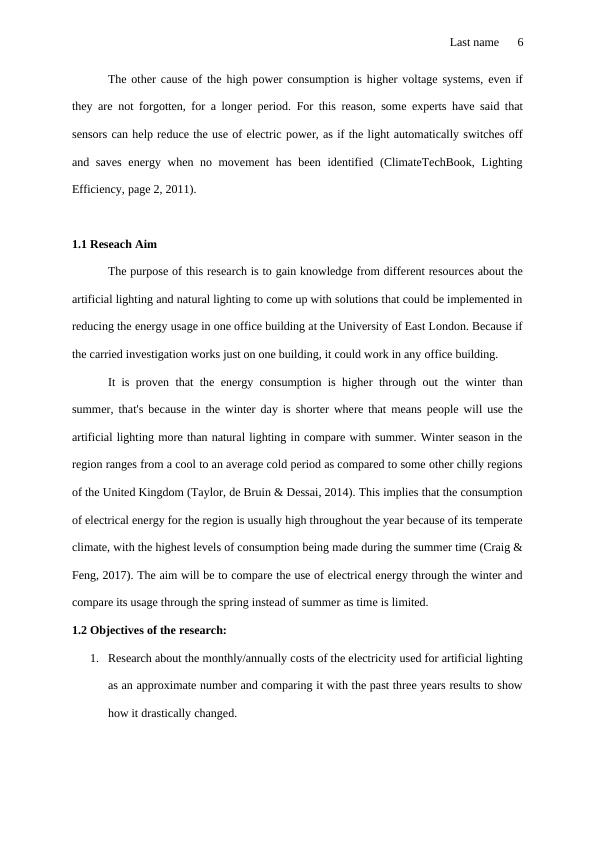How to Reduce Energy Consumption in Office Buildings
Added on 2023-01-16
32 Pages7663 Words49 Views
Last name 1
HOW TO REDUCE THE ENERGY CONSUMPTION INTO THE OFFICE
BUILDINGS
HOW TO REDUCE THE ENERGY CONSUMPTION INTO THE OFFICE
BUILDINGS

Last name 2
Abstract
The objective of this research was to choose an office building at the University of
East London as a case study, to study only one room in a building, namely the Knowledge
Dock. It is known that this consumes a large amount of electricity and contributes to the use
of passive natural light for people, which affects the level of comfort. This research, although
not detailed, provides a considerable insight into ways to conserve energy. in the area of a
building that requires the highest consumption and consumption of energy. This research can
become a basis for other researchers who are interested in this topic to get used to the
different forms and technologies that have been introduced to save energy or reduce costs. By
introducing systems that reduce costs and increase, profits are better than wasting scarce
resources. To calculate the future benefit of the investment made today can be seen in terms
of gas cost savings, maintenance costs and electricity costs.
Keywords: Energy Consumption, Artificial Lighting, Energy Consumption Solution,
Reducing Temperature, East London
Abstract
The objective of this research was to choose an office building at the University of
East London as a case study, to study only one room in a building, namely the Knowledge
Dock. It is known that this consumes a large amount of electricity and contributes to the use
of passive natural light for people, which affects the level of comfort. This research, although
not detailed, provides a considerable insight into ways to conserve energy. in the area of a
building that requires the highest consumption and consumption of energy. This research can
become a basis for other researchers who are interested in this topic to get used to the
different forms and technologies that have been introduced to save energy or reduce costs. By
introducing systems that reduce costs and increase, profits are better than wasting scarce
resources. To calculate the future benefit of the investment made today can be seen in terms
of gas cost savings, maintenance costs and electricity costs.
Keywords: Energy Consumption, Artificial Lighting, Energy Consumption Solution,
Reducing Temperature, East London

Last name 3
CONTENTS
Abstract................................................................................................................................................2
1- INTRODUCTION.......................................................................................................................5
1.1 Reseach Aim...............................................................................................................................6
1.2 Objectives of the research:........................................................................................................6
1.3 Research Questions....................................................................................................................7
1.3 Scope...........................................................................................................................................7
1.4 Assumptions...............................................................................................................................7
2- LITERATURE REVIEW...........................................................................................................9
2.1- Energy consumption and Artificial lighting...........................................................................9
2.2- Reduce Energy Consumption by focusing on artificial Lighting..........................................9
2.3- Energy consumption in buildings policies............................................................................10
2.4- Energy in buildings................................................................................................................10
2.5- Hybrid Solar Lighting............................................................................................................11
2.6- Use of Light Emitting Diode (LED) in Knowledge Dock.....................................................12
2.7- Use of BMS for the Building..................................................................................................12
2.8- Motion Sensors and Energy Consumption...........................................................................13
3- METHODOLOGY........................................................................................................................15
3.1 Research Design.......................................................................................................................15
3.2 Research Strategy and Research Programme.......................................................................15
3.3 Data Analysis...........................................................................................................................15
3.4 Research Obstacles..................................................................................................................16
3.5 Ethical Considerations............................................................................................................16
3.6 Procedure.................................................................................................................................16
3.7 Validity and Reliability...........................................................................................................17
3.8 Research Design.......................................................................................................................18
3.9 Project timeline........................................................................................................................19
CHAPTER 4 DATA ANALYSIS.....................................................................................................20
CHAPTER 5......................................................................................................................................26
5.1- Conclusion...............................................................................................................................26
5.2- Recommendations..................................................................................................................27
5.2.1- Use of Building Management Systems (BMS)..................................................................27
5.2.2- Occupancy Sensors............................................................................................................27
5.2.3- Holiday Scheduling...........................................................................................................27
CONTENTS
Abstract................................................................................................................................................2
1- INTRODUCTION.......................................................................................................................5
1.1 Reseach Aim...............................................................................................................................6
1.2 Objectives of the research:........................................................................................................6
1.3 Research Questions....................................................................................................................7
1.3 Scope...........................................................................................................................................7
1.4 Assumptions...............................................................................................................................7
2- LITERATURE REVIEW...........................................................................................................9
2.1- Energy consumption and Artificial lighting...........................................................................9
2.2- Reduce Energy Consumption by focusing on artificial Lighting..........................................9
2.3- Energy consumption in buildings policies............................................................................10
2.4- Energy in buildings................................................................................................................10
2.5- Hybrid Solar Lighting............................................................................................................11
2.6- Use of Light Emitting Diode (LED) in Knowledge Dock.....................................................12
2.7- Use of BMS for the Building..................................................................................................12
2.8- Motion Sensors and Energy Consumption...........................................................................13
3- METHODOLOGY........................................................................................................................15
3.1 Research Design.......................................................................................................................15
3.2 Research Strategy and Research Programme.......................................................................15
3.3 Data Analysis...........................................................................................................................15
3.4 Research Obstacles..................................................................................................................16
3.5 Ethical Considerations............................................................................................................16
3.6 Procedure.................................................................................................................................16
3.7 Validity and Reliability...........................................................................................................17
3.8 Research Design.......................................................................................................................18
3.9 Project timeline........................................................................................................................19
CHAPTER 4 DATA ANALYSIS.....................................................................................................20
CHAPTER 5......................................................................................................................................26
5.1- Conclusion...............................................................................................................................26
5.2- Recommendations..................................................................................................................27
5.2.1- Use of Building Management Systems (BMS)..................................................................27
5.2.2- Occupancy Sensors............................................................................................................27
5.2.3- Holiday Scheduling...........................................................................................................27

Last name 4
5.2.4- Use of LEDs......................................................................................................................27
5.2.5- Chiller Optimization..........................................................................................................28
5.3- Future Implications................................................................................................................28
APPENDIX.........................................................................................................................................31
Table 1: Questionnaire Statistics.........................................................................................................18
Figure 1: Occupation...........................................................................................................................18
Figure 2: Hours spent in room.............................................................................................................19
Figure 3: Hours spent outside room.....................................................................................................20
Figure 4: Sunlight access to space.......................................................................................................20
5.2.4- Use of LEDs......................................................................................................................27
5.2.5- Chiller Optimization..........................................................................................................28
5.3- Future Implications................................................................................................................28
APPENDIX.........................................................................................................................................31
Table 1: Questionnaire Statistics.........................................................................................................18
Figure 1: Occupation...........................................................................................................................18
Figure 2: Hours spent in room.............................................................................................................19
Figure 3: Hours spent outside room.....................................................................................................20
Figure 4: Sunlight access to space.......................................................................................................20

Last name 5
1- INTRODUCTION
Electrical vitality is a standout amongst the most usually utilised wellsprings of
vitality in place of business. This wellspring of sustainable power source is incredibly
profitable as it adds to the general maintainability of the environment and the monetary
working (Ochoa et al., 2012). While the utilisation of vitality is normal to any structure, its
utilisation for the places of business has been observed to be expansive. Places of business in
the United Kingdom alone utilise a normal of right around 18 kilowatts for each hour of
power which adds to the money related weights of the structure and the maintainability of the
regular habitat also.
Moving on, research has shown that the study of this consumption of electrical
energy is especially crucial for the regions where the climate is relatively warm as the heat
encourages the employees that are working within an office building to turn on the cooling
systems and air conditioners which ultimately adds to the consumption of the electrical
energy (Ochoa et al., 2012). This research aims to choose an office building of the University
of East London as a case study in order to study only one room in a building using a great
deal of electricity and which also contributes to the utilisation of passive natural daylight for
the people which affects the level of comfort.
The electrical area to be examined is based on artificial lighting. This is because of the
higher use of electricity for illumination in office buildings, as stated by Pew Center on
Global Climate Change that 11% electricity is used in residential buildings, and 18% is used
in office buildings (ClimateTechBook, Lighting Efficiency, page 1, 2011). The long working
times and the number of employees/students who are spending time in the building are the
main cause of high energy consumption, given the larger area of the building that will
increase the use of artificial illumination and reduce the natural lighting consumption.
1- INTRODUCTION
Electrical vitality is a standout amongst the most usually utilised wellsprings of
vitality in place of business. This wellspring of sustainable power source is incredibly
profitable as it adds to the general maintainability of the environment and the monetary
working (Ochoa et al., 2012). While the utilisation of vitality is normal to any structure, its
utilisation for the places of business has been observed to be expansive. Places of business in
the United Kingdom alone utilise a normal of right around 18 kilowatts for each hour of
power which adds to the money related weights of the structure and the maintainability of the
regular habitat also.
Moving on, research has shown that the study of this consumption of electrical
energy is especially crucial for the regions where the climate is relatively warm as the heat
encourages the employees that are working within an office building to turn on the cooling
systems and air conditioners which ultimately adds to the consumption of the electrical
energy (Ochoa et al., 2012). This research aims to choose an office building of the University
of East London as a case study in order to study only one room in a building using a great
deal of electricity and which also contributes to the utilisation of passive natural daylight for
the people which affects the level of comfort.
The electrical area to be examined is based on artificial lighting. This is because of the
higher use of electricity for illumination in office buildings, as stated by Pew Center on
Global Climate Change that 11% electricity is used in residential buildings, and 18% is used
in office buildings (ClimateTechBook, Lighting Efficiency, page 1, 2011). The long working
times and the number of employees/students who are spending time in the building are the
main cause of high energy consumption, given the larger area of the building that will
increase the use of artificial illumination and reduce the natural lighting consumption.

Last name 6
The other cause of the high power consumption is higher voltage systems, even if
they are not forgotten, for a longer period. For this reason, some experts have said that
sensors can help reduce the use of electric power, as if the light automatically switches off
and saves energy when no movement has been identified (ClimateTechBook, Lighting
Efficiency, page 2, 2011).
1.1 Reseach Aim
The purpose of this research is to gain knowledge from different resources about the
artificial lighting and natural lighting to come up with solutions that could be implemented in
reducing the energy usage in one office building at the University of East London. Because if
the carried investigation works just on one building, it could work in any office building.
It is proven that the energy consumption is higher through out the winter than
summer, that's because in the winter day is shorter where that means people will use the
artificial lighting more than natural lighting in compare with summer. Winter season in the
region ranges from a cool to an average cold period as compared to some other chilly regions
of the United Kingdom (Taylor, de Bruin & Dessai, 2014). This implies that the consumption
of electrical energy for the region is usually high throughout the year because of its temperate
climate, with the highest levels of consumption being made during the summer time (Craig &
Feng, 2017). The aim will be to compare the use of electrical energy through the winter and
compare its usage through the spring instead of summer as time is limited.
1.2 Objectives of the research:
1. Research about the monthly/annually costs of the electricity used for artificial lighting
as an approximate number and comparing it with the past three years results to show
how it drastically changed.
The other cause of the high power consumption is higher voltage systems, even if
they are not forgotten, for a longer period. For this reason, some experts have said that
sensors can help reduce the use of electric power, as if the light automatically switches off
and saves energy when no movement has been identified (ClimateTechBook, Lighting
Efficiency, page 2, 2011).
1.1 Reseach Aim
The purpose of this research is to gain knowledge from different resources about the
artificial lighting and natural lighting to come up with solutions that could be implemented in
reducing the energy usage in one office building at the University of East London. Because if
the carried investigation works just on one building, it could work in any office building.
It is proven that the energy consumption is higher through out the winter than
summer, that's because in the winter day is shorter where that means people will use the
artificial lighting more than natural lighting in compare with summer. Winter season in the
region ranges from a cool to an average cold period as compared to some other chilly regions
of the United Kingdom (Taylor, de Bruin & Dessai, 2014). This implies that the consumption
of electrical energy for the region is usually high throughout the year because of its temperate
climate, with the highest levels of consumption being made during the summer time (Craig &
Feng, 2017). The aim will be to compare the use of electrical energy through the winter and
compare its usage through the spring instead of summer as time is limited.
1.2 Objectives of the research:
1. Research about the monthly/annually costs of the electricity used for artificial lighting
as an approximate number and comparing it with the past three years results to show
how it drastically changed.

Last name 7
2. To research the use of different artificial lighting systems with a lower and higher
voltage to find out which is more economical for Knowledge dock.
3. To research about the effective use of artificial lighting sources and the passive
daylighting as a means for better management of the use of energy consumption at the
Knowledge Dock.
4. To come up with different solutions to contribute to reducing the energy consumption
in the Knowledge Dock or office building, especially in that location that has a
temperate climate.
5. Using devices to measure the lux per meter square that is provided by the natural
daylighting and a separate device to measure the power of the lighting into the
specific area from the Knowledge Dock.
1.3 Research Questions
What are the methods of artificial and natural lighting which would be beneficial for
the Knowledge dock?
What solutions will help in contributing to minimise consumption of energy in office
buildings where there is a temperature climate?
1.3 Scope
As already specified, this study is mainly limited to Office buildings and the survey
will mainly be conducted on those companies, which have their offices in London and want
to find ways to have more efficient energy consumption where there is a temperature climate.
1.4 Assumptions
To find out and effectively attain the objective of this study, the researcher will
undertake the basic assumptions that office buildings, which are taken in research, represent
the major portion of the industry. The second assumption would be that no office have
2. To research the use of different artificial lighting systems with a lower and higher
voltage to find out which is more economical for Knowledge dock.
3. To research about the effective use of artificial lighting sources and the passive
daylighting as a means for better management of the use of energy consumption at the
Knowledge Dock.
4. To come up with different solutions to contribute to reducing the energy consumption
in the Knowledge Dock or office building, especially in that location that has a
temperate climate.
5. Using devices to measure the lux per meter square that is provided by the natural
daylighting and a separate device to measure the power of the lighting into the
specific area from the Knowledge Dock.
1.3 Research Questions
What are the methods of artificial and natural lighting which would be beneficial for
the Knowledge dock?
What solutions will help in contributing to minimise consumption of energy in office
buildings where there is a temperature climate?
1.3 Scope
As already specified, this study is mainly limited to Office buildings and the survey
will mainly be conducted on those companies, which have their offices in London and want
to find ways to have more efficient energy consumption where there is a temperature climate.
1.4 Assumptions
To find out and effectively attain the objective of this study, the researcher will
undertake the basic assumptions that office buildings, which are taken in research, represent
the major portion of the industry. The second assumption would be that no office have

Last name 8
inefficient energy consumption throughout the time of research, to avoid any kind of
disruption.
inefficient energy consumption throughout the time of research, to avoid any kind of
disruption.

End of preview
Want to access all the pages? Upload your documents or become a member.
Related Documents
Design and Implementation of Automatic Street Light Control System using Light Dependent Resistor and Relaylg...
|45
|10141
|463
Energy Audit for Residential House in Brisbane, Australialg...
|30
|8280
|433
B5U54 - Building Management Systemslg...
|33
|12905
|33
Building Information Modelling (BIM) Assignmentlg...
|40
|7435
|497
Solar Power System: Providing Sustainable Solution for Flat Studiolg...
|27
|6165
|168
1 EFFICENT ENERGY USE IN AUSTRALIA HOSPITALS Energy Efficiency in Australialg...
|26
|6286
|473